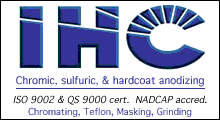
Curated with aloha by
Ted Mooney, P.E. RET

The authoritative public forum
for Metal Finishing 1989-2025

-----
Copper contamination in chromic anodizing solution
July 31, 2008
Hi everybody. I am working at a chemical lab for support to chemical processing shops (periodic testing and such) and we are setting up a small anodising shop (around 150 L. tanks) for the preparation of test specimens for paint testing (mainly adhesion tests). We had nice results at the beginning but lately we have observed a decrease in the anodic film thickness, even if the rest of the tests are still fine (SST, coating weight, adhesion). We are using aluminum racks with copper hooks for better electrical contact; those copper hooks are very close to the surface of the solution and we think that it may have been in contact with it by accident, because the copper seems to have been dissolved in those regions
(sorry, I don't have a picture). Maybe I am asking something obvious here, but could the copper content in the solution affect the growth of the anodic layer somehow?
Thank you for your help and your time
Best regards
Special processes chem. lab. - Spain
First of two simultaneous responses --
The literature seems scant on copper contamination, but have you been running the 2000 alloys which are not recommended for chromic acid anodizing.
Check for sulphates. Sulfats over 500 gm/L will seriously lower the coating weight and the corrosion protection.
Check for tri-valent. This forms when the cathode area is too large. You can knock it down by electrolysing at 3 to 6 volts with two lead cathodes.
LET US KNOW WHAT HAPPENED WHEN YOU GET THE COATING WEIGH RESTORED.

Robert H Probert
Robert H Probert Technical Services
Garner, North Carolina

August 4, 2008
Second of two simultaneous responses --
Hi!
Being a testing laboratory,I think it would be worthwhile for you to invest in pure Titanium jigs.They will give you good conductivity and are long lasting.Hope that helps.
- Belgaum, India
August 5, 2008
I do not think that any large commercial anodizer uses copper contacts. They will use copper as far as possible to avoid line loss and then will switch to aluminum or titanium for the racking that is in the solution. The solution helps to keep the temp of the immersed rack down, so you do not have a lot of electrical loss there. The components that are exposed to the air tend to act like a heater so the temp will rise rapidly if the conductor is not large enough for the wattage.
Aluminum racks are actually preferred for anodizing, but cleaning them eats away a lot of the material resulting in replacement on regular intervals. Ti has other problems such as being a poor conductor and initially expensive, but they last a long time.
- Navarre, Florida
August 5, 2008
finishing.com is made possible by ...
for Chromic Acid Anodizing [Detroit, MI]

Q, A, or Comment on THIS thread -or- Start a NEW Thread